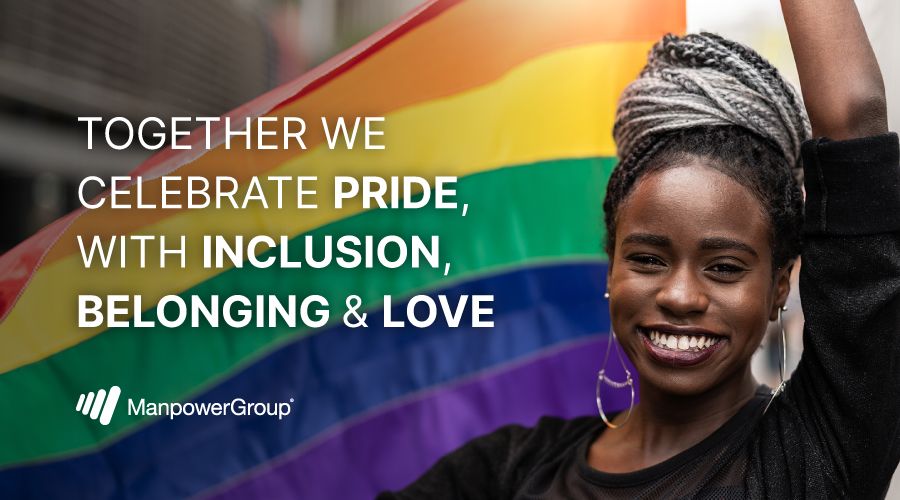How to Embrace Diversity at Work and Support Our LGBTQIA+ Colleagues Year-Round

June is Pride Month, the vibrant celebration of diversity, equity, inclusion, and belonging (DEIB). It's a time to recognize and show allyship to our lesbian, gay, bisexual, transgender (transsexual), queer (questioning), intersex, and allied (asexual/aromantic/agender) (LGBTQIA+) family, friends, and colleagues.
While many of the festivities are revelatory, they should also serve as a crucial reminder for organizations worldwide to create inclusive workplaces that embrace people feeling safe and welcome to bring their true, authentic selves to work during the other 11 months of the year.
Here are some impactful ways to support our LGBTQIA+ colleagues at work, champion inclusivity throughout the year, and ensure that Pride Month is more than just a performative display with a shelf-life lasting June’s 30 days:
1. Build an LGBTQIA+ support network
To attract and retain LGBTQIA+ employees, it's essential to create visible support within the company. Encourage LGBTQIA+ staff business resource groups (BRGs) and other work-social groups and extend the same opportunities for extracurricular activities. These initiatives provide a sense of belonging and demonstrate your commitment to fostering an inclusive environment 24/7/365.
Additionally, you can forge partnerships with local LGBTQIA+ groups, such as community centers, advocacy organizations, and charities. Engaging with these groups demonstrates long-term commitment and offers valuable insights into the challenges faced by LGBTQIA+ individuals. It also paves the way for positive social change.
2. Develop an effective corporate DEIB policy
Crafting a clear and comprehensive DEIB policy is crucial to fostering a welcoming, inclusive environment. Explicitly include sexual orientation, gender identity, expression, and sex characteristics/intersex status to reinforce your commitment. The policy should outline both the company's and employees' responsibilities while emphasizing the consequences of policy violations. By establishing and driving DEIB initiatives, you can help improve buy-in from all levels of your organization. Encourage empathy by exposing employees to diverse perspectives and viewpoints. Regularly train them on DEIB, ensuring their familiarity with the policy.
A truly inclusive workplace is one where individuals from diverse backgrounds feel seen, heard, and valued. Rather than blending in, they bring a unique perspective that challenges homogeneity in attitudes, values, and beliefs. To foster allyship and equal opportunities for LGBTQIA+ employees, go further than just checking a few boxes. Promote a diverse pool of candidates for senior leadership and board positions, while providing comprehensive training to managers and employees on inclusive behaviors. Seek individuals who possess curiosity, humility, and courage. Leaders who exhibit a passion for learning, the humility to acknowledge mistakes, and the courage to speak out against injustices lay the foundation for lasting change.
3. Leverage technology to establish best practices
DEIB technology has evolved to support companies in implementing inclusive policies and practices. Leverage these tools to gain valuable insights, reduce bias, enhance transparency, and offer timely analytics. The World Economic Forum's Diversity, Equity, and Inclusion 4.0 toolkit provides an excellent resource to explore the myriad opportunities offered by technology.
4. Listen, apologize, and learn from mistakes
“To Err is Human; to Forgive, Divine.” - Alexander Pope
We all make mistakes. Recognize that missteps may occur along the DEIB journey. If you're called out for microaggression or an act of exclusion, respond with compassion, concern, and humility. Make a sincere effort to listen and understand, apologize genuinely, and avoid making the situation about yourself. This compassionate response fosters a culture of learning and growth. Know that growing pains are part of the process. If you make a mistake and are quick to right the wrongs, you can build an open, transparent, and more trusting environment where we know mistakes will be made and forgiveness can be doled out.
5. Set targets and track progress
Hold your company accountable by setting measurable targets and regularly tracking progress. Senior decision-makers should receive frequent updates on DEIB efforts, including employee experience and engagement levels. If you don’t already have one, appointing a senior-level officer to oversee and direct DEIB initiatives, education, and training ensures that inclusion remains a priority. Implementing it at the C-Suite level will show that an organization is taking seriously its role in holding everyone, from the top down, accountable.
While these aforementioned tips represent a small fraction of the ways you can make a difference in the lives of our LGBTQIA+ colleagues, you should also take the initiative to conduct research and educate yourself.
A good place to start is with the United Nations Human Rights Office's Standards of Conduct. This is an invaluable resource that provides guidance on supporting LGBTQIA+ rights in the workplace, marketplace, and community. This collaborative effort by numerous companies across sectors ensures a comprehensive understanding of best practices.
At ManpowerGroup, we firmly believe that businesses play a pivotal role in driving positive societal change. By intentionally creating diverse and inclusive workplaces, organizations can attract top talent and foster innovation. Supporting our LGBTQIA+ colleagues year-round goes beyond symbolism, generating tangible benefits for individuals and the bottom line. Together, we can build a future where everyone feels valued, respected, and empowered. Let us embrace diversity, celebrate authenticity, and continue championing inclusivity every day of the year.
Download the LGBTQIA+ Inclusive #WordsatWork Guide to learn more about proper pronoun usage.
